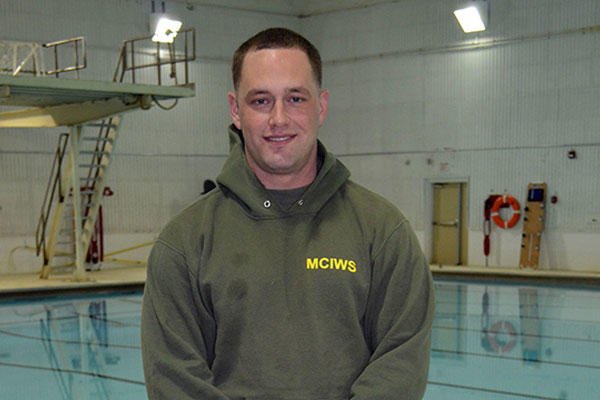QUANTICO, Va. – The Marine Combat Instructor of Water Survival course is a grueling training evolution that requires Marines to swim a total of 59 miles over three weeks.
Just six of nine course students were able to complete the challenge and graduate Nov. 25. One of those six course students had the deck stacked against him from the beginning, but he overcame adversity and graduated with his classmates.
Marine Corps Staff Sgt. Adam Jacks, company gunnery sergeant for Headquarters and Service Company at The Basic School here, is a motivated, extremely fit, Marine who said he quickly volunteered to attend the course when approached by the chief instructor trainer, Marine Corps Gunnery Sgt. Joseph Marshall. The fact that Jacks’s right leg was amputated at the mid-thigh in 2011 did not faze either Marine.
Injured in Afghanistan
Jacks, a native of Newark, Ohio, was serving in Afghanistan with 3rd Battalion, 8th Marine Regiment, when he stepped on a pressure plate April 3, 2011, and was hit by an improvised explosive device blast. Among other injuries, Jacks suffered a traumatic brain injury and lost two-thirds of his right leg.
Though he easily could have medically retired, Jacks said, he “fought pretty hard” to stay on active duty, believing he had much more to contribute to the Marine Corps.
“Why I wanted to stay in is pretty simple: I wasn’t ready to hang up the uniform and turn the page into a new chapter,” he said. “I felt that I had a lot of fight left in me, and that I could help shape the Marine Corps into this new-age style of fighting, even with half of a leg, and to show Marines of all ranks and ages that it still can be done.”
Jacks asked to be placed in an expanded permanent limited duty status, a request that only the commandant of the Marine Corps can grant. Jacks said he met the commandant -- Gen. James F. Amos at the time -- and that Amos said to him, “If you want to stay in, I won’t push you out.” After about nine months of evaluations and paperwork, Jacks was granted permission to continue serving on active duty.
Specific Prosthetics for Specific Activities
Jacks said he has about 20 different prosthetic legs, each with a unique purpose. He has one for everyday activities, one for patrolling and one for running, among others.
“If I don’t have one that works well for the situation, that will set me up for failure,” he explained. He also has one prosthetic decorated with a blood stripe and some Marine graphics that he said he doesn’t like to wear much, because he doesn’t want to damage it.
What he lacked before starting the course, however, was a leg that would help him swim. The asymmetry in his body caused him to roll in the water when swimming, Jacks said.
“The first week [of the MCIWS course] was pretty hellacious,” he said, “because I had to relearn how to swim properly and use my upper body.”
He recounted having to fight feelings of vertigo from the lack of balance. Marshall said he and Jacks worked together to improvise a buoyant prosthetic that would enable him to stay at a level position in the water. Even with the buoyant leg, Jacks had to put in dozens of extra training hours to become more proficient, frequently staying at the pool until 6:30 or 7 p.m., up to two hours after the other students had left for the day.
High Standards
“We were not going to lower the standard,” Marshall said. “We were going to work with him to help him reach it.” And the standard was high. Marines had to complete conditioning swims up to 1,900 meters in length, including three that were timed. They also had to swim 25 meters underwater, complete four American Red Cross rescues with the aid of lifesaving equipment and four without, and pass all academic classroom evaluations.
“There were naysayers” who told him he wouldn’t be able to complete the course missing a limb, Jacks said, but he kept a positive outlook.
“You press on with it,” he said. “You use the adversities as fuel to get you through.”
Jacks and his fellow graduates are now certified as MCIWS instructors and American Red Cross lifeguards.





























